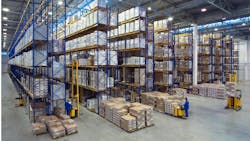Taking a Smart Approach to Warehouse Energy Efficiency
What you’ll learn:
- Warehouses that incorporate energy-efficient tech maintain competitive advantages despite expensive integrations.
- Energy data is critical for improving global warehousing, which is a sector with increasing annual emissions.
- Goals with clarity determine success when cutting energy use and reporting sustainability initiatives.
Trends in sustainability and digital transformation are calling for warehousing advancement. Smart systems and assets empower legacy businesses into a new era of energy efficiency and savings. What are the tools, approaches and benefits of integrating tech like AI and the Internet of Things (IoT) for energy efficiency? Competitive warehouses of the future embrace innovative challenges to help the planet and save resources.
Having a Goal-Oriented Workflow
Warehouse energy efficiency needs corporate goals to frame integrations—otherwise, the smart tech may use more energy than it saves. The upfront costs of equipment installation and data collection are exorbitant. Warehousing operational costs are already between $2 and $3 per square foot, and buildings keep getting bigger. The necessary square footage contracts will only skyrocket too, as sectors like e-commerce balloon beyond expectation and use copious amounts of electricity.
Therefore, each smart energy device in a warehouse must be mindful and applicable to any contract’s varied climate objectives. What are the tools warehouses must pick from when it comes to energy awareness?
- Battery storage systems
- Renewable energy equipment
- Internet of Things devices
- AI and machine learning
- 5G technologies
- Cloud infrastructure
- Green software, like a warehouse management system (WMS)
- Electrified and autonomous vehicles and machinery
Goals for greener power use must reinforce a company’s foundation as climate pressures consistently wear down on corporations. Future-proofing warehouses is top-of-mind for thought leaders in the sector, as trends are more nuanced and fast-paced, including nearshoring, modular design and regulatory changes catalyzed by legislation. These may all influence energy by consolidating assets or obtaining environmental certifications.
How could stakeholders forge goals that reveal a warehouse’s most valuable smart tools? If it already has solar panels, battery storage could increase revenue by adding a new sales vertical. IoT monitors with cloud syncing to databases inform operators when to perform maintenance based on anomalies in energy performance. Services like electrified AGVs and conscious green software simply shave overall consumption from previously wasteful resources.
Expecting Barriers
Energy-efficient operations have escaped warehousing because notable barriers prevent the intuitive incorporation of new equipment. The first is misconceptions related to the return on investment. Cost and ROI are why 40% of outfits do not adopt automation tools, which could enhance energy efficiency.
A smart, practical approach to adjusting this mindset is distinguishing long- and short-term ROIs. Introductory implementation and training may be costly, but the brand loyalty from B2B clients after increasing reputations in the sustainability space is priceless.
Additionally, reinforcing energy independence shields from ever-changing energy prices and related adverse impacts. Warehouses anticipate these losses in yearly budgets, preparing for them as if they are required expenses. However, warehouses should not be subject to the volatility of the fossil fuel industry, which will only become more chaotic as legislation, inflation, scarcity and geopolitical tensions force prices to waver.
Warehouses are already pushed to their limits. Manufacturers suffer from labor shortages while shelf spaces run low, yet the number of pallets needing to be packed and transported daily continues to surge. Boosting energy use would help overcome these troubles by adding more machinery and tools.
However, resisting this temptation is a part of a mindful process of discovery and optimization in warehouses. Knowing the barriers to achieving genuine efficiency in a warehouse prevents misinformed decision-making.
Visualizing Data Clarity
The average U.S. warehouse without refrigeration uses 6.1 kWh per square foot a year. Installing smart tools to discover the most power-intensive departments, machines and operations will guide more curated change managements. This makes the warehouse greener by minimizing waste.
For example, an ineffective HVAC system could be the reason a warehouse hemorrhages electricity. It could also be caused by employees needing to remember to turn off high-profile machines and even simple lights because of inadequate training. Warehouse managers and logistics experts may be unable to pinpoint these high-resource users without incorporating sensor-based gathering and quality data analytics.
Improper or neglectful maintenance on warehousing machines like palletizers may also run utility bills unnecessarily high. Worn-out belts and bearings or filled air filters exert energy systems. Smart systems identify where leaks and overstressed machinery are within the warehouse without wasting more resources on locating the concern.
Another example is RFID-based inventory tracking. It may reveal how the long-held stock uses excess power, illuminating space-saving opportunities. Automated scanners connect to software databases, notifying overseers when a warehouse is holding too much inventory and collecting dust.
Capitalizing on the Benefits
Warehouses account for 11% of carbon emissions in logistics, which translates to between 2% and 3% of global greenhouse gases. Using smart technology to find optimization opportunities gains more benefits than sustainability boons.
Optimizing transportation routes using micro-workflows is one of the best ways to speed up deliverables and minimize electricity expenditure. Inventory should be available for a full cargo load—if there are consistent issues with this, it means the warehouse is populated with products that are not serving the company. Streamlining travel also minimizes transfer shipments and the amount of power, fuel and waste required to orchestrate trade-offs.
A case study from UPS highlighted the diverse productivity and sustainability benefits smart systems in warehousing may deliver. First, they incorporated robots that required no heat or light to operate, permitting them to curb energy consumption in other warehouse areas. In their Netherlands branch, they replaced forklifts and tall racks with more accessible low-power robotic arms and grids with bins to save 400% more space.
Initiatives like incorporating LED lighting and obtaining the LEED certification will allow them to trim energy use further. This is the first step to other climate-conscious incorporations. For example, it will enable UPS to reach 100% renewable power by 2035 because the assets will supply more reasonable energy demands.
Smart in More Ways Than One
IoT technologies and smart strategies run rampant in the Industry 4.0 and 5.0 landscape because they effectively achieve higher sustainability. Intricate data wells from sensors reveal consumption trends to slash, and cloud-connected databases enlighten stakeholders if priorities must shift for greater efficiency gains. However, creating a plan to use energy more wisely in warehouses requires smart tools and planning. This powerful combination will make it more sustainable, which is necessary for decarbonizing the industry.
About the Author

Emily Newton
Emily Newton has eight years of creating logistics and supply chain articles under her belt. She loves helping people stay informed about industry trends. Her work in Supply Chain Connect, Global Trade Magazine and Parcel, showcases her ability to identify newsworthy stories. When Emily isn't writing, she enjoys building lego sets with her husband.






